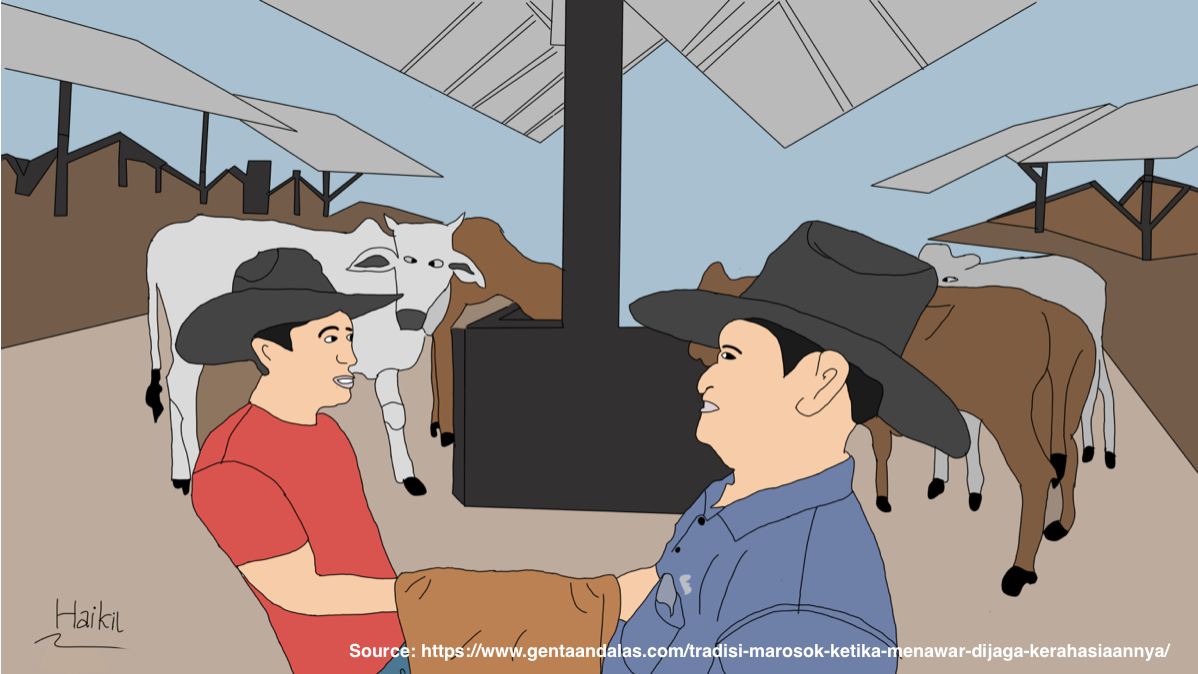Abstract
The marosok is a tradition of buying and selling livestock using hand movements and facial expressions in the bargaining process. The marosok tradition has denotative and connotative meanings associated with Minangkabau culture. The purpose of this study was to determine the meaning of denotation and connotation of the marosok tradition with an ethnographic approach using Symbolic Interactionism Theory and semiotic analysis of Pierce. This research method is qualitative by conducting literature study and interviews using snowball sampling technique to M. Azhadi Dt. Bosa as key informant who directs researchers to Desmon Korina and Hadiyati who understand the marosok tradition in the Payakumbuh community. This study shows that the tools, hand movements and expressions in the marosok tradition have meanings that must be understood by the parties involved in the transactions. The sarong is a covering tool that shows marosok tradition is only carried out by men. Finger gestures indicate digits up to millions, increasing, or decreasing bidding. Expressions indicate approval or rejection of the offered price. The marosok tradition ends with handshake and smile between the seller and the buyer. The marosok tradition creates healthy competition where the prices are only known by the parties concerned. However, this process is not transparent, the buyer can only estimate the weight and condition of the livestock by seeing and touching the livestock directly, so the buyer must be very careful in choosing livestock with good quality. The marosok tradition must be maintained so that the media is needed to teach how to do marosok to the younger generation. Apart from being a buying and selling transaction, the marosok tradition can be used as an attraction for tourists to come to Payakumbuh.
References
Fadhilah, S., & Dewi, E. A. S. (2017). Pola Komunikasi Tradisi Marosok Antara Sesama Penjual dalam Budaya Dagang Minangkabau. Jurnal Kajian Komunikasi, 5(2), 222–234. https://doi.org/10.24198/jkk.v5i2.10464
Fatanti, M. N., & Happy, N. (2019). Makna Kultural Tradisi Marosok. Jurnal Ilmu Komunikasi, 16(2). https://ojs.uajy.ac.id/index.php/jik/article/view/1633/1754
Hsb., M. A. F. (2015). Komunikasi Non Verbal dalam Pekan Ternak “ Marosok ” di Payakumbuh, Provinsi Sumatera Barat. E-Proceeding of Management, 2(3), 4200–4207.
Kamarusdiana, K. (2019). Studi Etnografi dalam Kerangka Masyarakat dan Budaya. SALAM: Jurnal Sosial Dan Budaya Syar-I, 6(2), 113–128. https://doi.org/10.15408/sjsbs.v6i2.10975
Kusumawati, T. I. (2016). Komunikasi Verbal Dan Nonverbal. Jurnal Pendidikan Dan Konseling, 6(2).
Maulani, F., Yurisman, & Endrizal. (2021). Ethnography Interaksi Simbolik Tradisi Marosok dalam Transaksi Jual Beli Ternak di Nagari Cubadak Kabupaten Tanah Datar Provinsi Sumatera Barat. Journal of Cultural Anthropology, 1(1).
Mayasari, D. (2019). Bahasa Tubuh Berperan Hingga 55 Persen dalam Komunikasi. Www.Timesindonesia.Co.Id.
Nurdiani, N. (2014). Teknik Sampling Snowball dalam Penelitian Lapangan. ComTech: Computer, Mathematics and Engineering Applications, 5(2), 1110. https://doi.org/10.21512/comtech.v5i2.2427
Oktavianus. (2006). Cerminan Nilai Budaya Lintas Budaya. Jurnal Ilmiah Bahasa Dan Sastra, 11(2).
Pica-Ciamarra, U., Otte, J., & Martini, C. (2010). A Living from Livestock Pro-Poor Livestock Policy Initiative Livestock Sector Policies and Programmes in Developing Countries A Menu for Practitioners.
Regina. (2017). TRADISI MAROSOK DALAM TRANSAKSI JUAL BELI TERNAK DI PASAR TERNAK KOTA PAYAKUMBUH, SUMATERA BARAT. JOM FISIP, 4(2).
Sugiyono. (2013). Metode Penelitian Kualitatif, Kuantitatif, dan R&D. Penerbit.
Umassari, A. R. (2017). Interaksi Simbolik dalam Proses Komunikasi Jual Beli Ternak “Marosok” di Payakumbuh Sumatera Barat. Universitas Sumatera Utara Medan.
Wulandari, S., & Siregar, E. D. (2020). Kajian Semiotika Charles Sanderspierce: Relasitrikotomi (Ikon,Indeks dan Simbol) dalam Cerpenanak Mercusuar karya Mashdar Zainal. Titian: Jurnal Ilmu Humaniora, 04(1), 29–41.
Yasmine, N. F. (2018). Keabsahan Transaksi Jual Beli Hewan Ternak pada Tradisi Marosok di Minangkabau Serta Akibat Hukumnya bagi Para Pihak. Universitas Katolik Parahyangan.

This work is licensed under a Creative Commons Attribution-NonCommercial 4.0 International License.
Copyright (c) 2022 ETNOSIA : Jurnal Etnografi Indonesia





